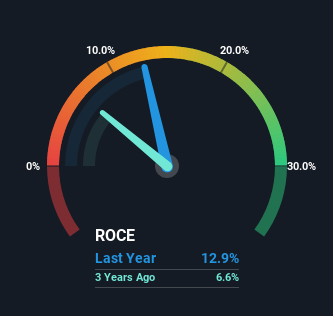- United States
- /
- Electric Utilities
- /
- NasdaqGS:OTTR
Otter Tail (NASDAQ:OTTR) Shareholders Will Want The ROCE Trajectory To Continue
Did you know there are some financial metrics that can provide clues of a potential multi-bagger? Firstly, we'll want to see a proven return on capital employed (ROCE) that is increasing, and secondly, an expanding base of capital employed. Put simply, these types of businesses are compounding machines, meaning they are continually reinvesting their earnings at ever-higher rates of return. Speaking of which, we noticed some great changes in Otter Tail's (NASDAQ:OTTR) returns on capital, so let's have a look.
Understanding Return On Capital Employed (ROCE)
For those who don't know, ROCE is a measure of a company's yearly pre-tax profit (its return), relative to the capital employed in the business. The formula for this calculation on Otter Tail is:
Return on Capital Employed = Earnings Before Interest and Tax (EBIT) ÷ (Total Assets - Current Liabilities)
0.13 = US$370m ÷ (US$3.2b - US$310m) (Based on the trailing twelve months to September 2023).
Thus, Otter Tail has an ROCE of 13%. On its own, that's a standard return, however it's much better than the 4.4% generated by the Electric Utilities industry.
View our latest analysis for Otter Tail

In the above chart we have measured Otter Tail's prior ROCE against its prior performance, but the future is arguably more important. If you'd like, you can check out the forecasts from the analysts covering Otter Tail here for free.
The Trend Of ROCE
The trends we've noticed at Otter Tail are quite reassuring. The data shows that returns on capital have increased substantially over the last five years to 13%. The amount of capital employed has increased too, by 54%. The increasing returns on a growing amount of capital is common amongst multi-baggers and that's why we're impressed.
Our Take On Otter Tail's ROCE
In summary, it's great to see that Otter Tail can compound returns by consistently reinvesting capital at increasing rates of return, because these are some of the key ingredients of those highly sought after multi-baggers. Since the stock has returned a staggering 108% to shareholders over the last five years, it looks like investors are recognizing these changes. With that being said, we still think the promising fundamentals mean the company deserves some further due diligence.
Since virtually every company faces some risks, it's worth knowing what they are, and we've spotted 2 warning signs for Otter Tail (of which 1 shouldn't be ignored!) that you should know about.
While Otter Tail may not currently earn the highest returns, we've compiled a list of companies that currently earn more than 25% return on equity. Check out this free list here.
New: AI Stock Screener & Alerts
Our new AI Stock Screener scans the market every day to uncover opportunities.
• Dividend Powerhouses (3%+ Yield)
• Undervalued Small Caps with Insider Buying
• High growth Tech and AI Companies
Or build your own from over 50 metrics.
Have feedback on this article? Concerned about the content? Get in touch with us directly. Alternatively, email editorial-team (at) simplywallst.com.
This article by Simply Wall St is general in nature. We provide commentary based on historical data and analyst forecasts only using an unbiased methodology and our articles are not intended to be financial advice. It does not constitute a recommendation to buy or sell any stock, and does not take account of your objectives, or your financial situation. We aim to bring you long-term focused analysis driven by fundamental data. Note that our analysis may not factor in the latest price-sensitive company announcements or qualitative material. Simply Wall St has no position in any stocks mentioned.
About NasdaqGS:OTTR
Otter Tail
Engages in electric utility, manufacturing, and plastic pipe businesses in the United States.
Excellent balance sheet established dividend payer.
Similar Companies
Market Insights
Community Narratives



